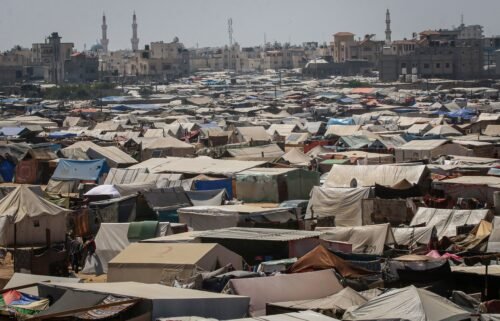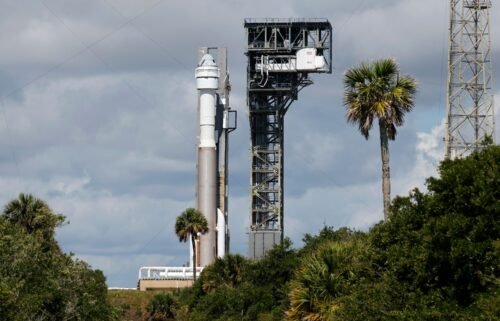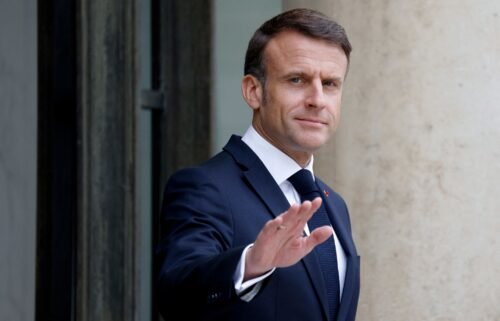This project cuts emissions by putting data centers inside wind turbines
(CNN) — Accounting for up to 1.5% of global electricity use, data centers are fueling the climate crisis. Currently, there are estimated to be more than 8,000 data centers worldwide, with more being planned every year to power the rise in global digital services.
While there have been efforts to reduce their carbon footprint using wind energy, a new German-based project takes it one step further.
WindCORES, a subsidiary of German renewable electricity company WestfalenWIND, operates data centers inside wind turbines located in a wind park in the Paderborn district in western Germany, which the company says makes the centers almost carbon neutral.
“If you look at the sustainability pyramid, the highest form of sustainability is using things that already exist,” said Fiete Dubberke, managing director of windCORES, which was founded in 2018.
The concept uses existing wind turbines to power data centers on site, while fiber optic cables provide a constant internet connection. Planning for a project like this began 10 years ago, Dubberke said, when WestfalenWIND realized the electricity grid was too weak to handle the huge capacities of electricity being produced by its wind turbines during peak wind hours, resulting in their windfarms being switched off due to grid security issues. WindCORES estimates that the unused electricity generated during this period could power one-third of all German data centers.
Its solution was to bypass the “middleman” (the grid) altogether, and instead, power IT servers from directly inside the large concrete wind turbine towers. Each tower is 13 meters wide and could potentially hold server racks up to 150 meters high. As the area is mostly empty space, Dubberke calls the concept a “no-brainer.”
According to Dubberke, an average of 85-92% of the power needed to sustain a windCORES data center comes directly from the host turbine. When there is no wind, electricity is obtained from other renewable sources, including solar farms and hydroelectric power plants, via the electricity grid.
“The German data center average is 430 grams of CO2 released per kilowatt hour,” he said. “For windCORES, it is calculated at just 10 grams per kilowatt hour.”
Streaming
Since launching, windCORES has acquired around 150 clients through co-location and cloud solutions, from very small start-up companies to bigger, more established ones, such as Zattoo, a leading carbon-neutral Swiss TV streaming platform with several million monthly users. Zattoo joined windCORES in 2020, when it moved one of its six data centers into a wind turbine in Paderborn. Currently, 218 channels are encoded with windCORES, and by the end of next year, the company hopes to relocate more existing servers to the wind farm, making it Zattoo’s main data center location.
Viliyana Ivanova, an engineering director leading the operations for the windCORES project at Zattoo, says the concept has so far been reliable, and fulfils Zattoo’s key objective for joining the initiative.
“The main reason why we decided to kick off this project, and spend the time making it work was because they were green,” she said. “In other big data centers, while they would tell us they use green energy, we couldn’t see the reports – there was no transparency for our own calculations. It’s not only to tell our customers we’re being green, but to actually know that we are.”
As a streaming company with multiple live channels that run non-stop, Viliyana recognizes the huge negative impact it can have on the environment, and the need to reduce emissions. To date, Zattoo says it has saved around 60 tons of CO2 through the windCORES project, but Viliyana also believes there is no easy solution.
“As a user, we all need those services to run, and I don’t want to give them up, so we need to find a way to make them better,” she said. “But the bigger you are, the more difficult it becomes, and the more links in the chain you need to consider, like the manufacturing of the equipment that is used, and the delivery of that equipment. It’s much more complex than just running the data center, but the general trend I can see in the world is that data centers are getting better and better [in terms of lower emissions].”
Dubberke calls Zattoo a “first mover,” as it was one of the first companies to implement the project, and he praises Zattoo’s open-mindedness and trust, a lack of which is the biggest challenge faced by windCORES.
“The IT industry is very conservative,” said Dubberke. “If you talk to, especially big IT companies, they’ll ask why they should put their million-dollar investment in the middle of a field. The only thing we can do is explain what we’re doing and how we’re doing it.”
Curtailment
According to Asim Hussain, chairperson and executive director of the non-profit Green Software Foundation, the windCORES concept is “quite clever” because it battles one of the biggest issues in renewable energy: curtailment.
“When there’s more electricity being generated than people are consuming, you can’t store it, there’s no big batteries – so you just have to throw it away; that’s curtailment,” he explained. “Now, it doesn’t matter even if they’re [windCORES] told to throw electricity away [by the electricity grid], they’ve got their own data center to power.”
Hussain, who is not involved with windCORES, also points to the solution-based innovation of what he calls “carbon-aware computing”.
“In the engineering space, we’re so disconnected from nature,” he said. “Whereas with this project, you’re connected with wind fully, and you’re trying to engineer solutions that are aligned with nature and work with nature.”
But he also recognizes not all “workload types” may be able to benefit from this concept, and that scalability could be a challenge. “I think people don’t quite realize just how massive data centers are,” he said. “People should see pictures of them. They’re absolutely massive. And even how big a wind turbine is, it’s nowhere near.”
WindCORES has recently opened a larger, second location called “windCORES II” at the Huser Klee windfarm in Lichtenau, Germany. Built for a new large automotive client from Munich (the name is yet to be revealed), it is over three levels and around 20 meters high.
But while Dubberke hopes the project will continue to grow and attract more high-power clients, he realizes it cannot go on forever. “In the long run, society is to be changed to green and sustainable – one day you will get green electricity directly from anywhere,” he said. “So, in 10 to 15 years, our concept won’t have the pull effect anymore because everything is sustainable.”
The-CNN-Wire
™ & © 2023 Cable News Network, Inc., a Warner Bros. Discovery Company. All rights reserved.


